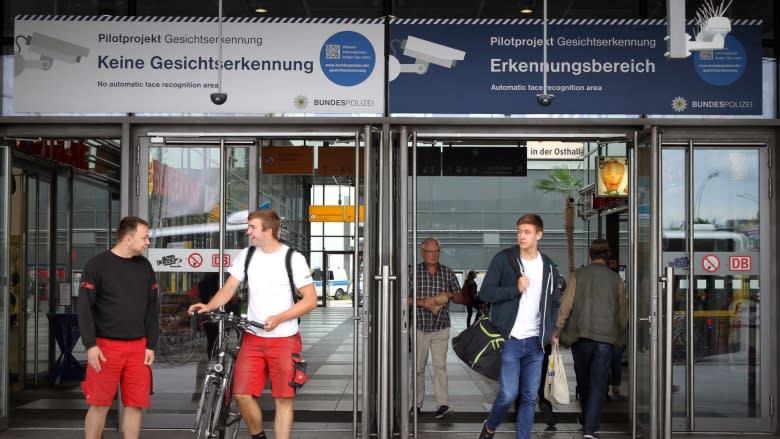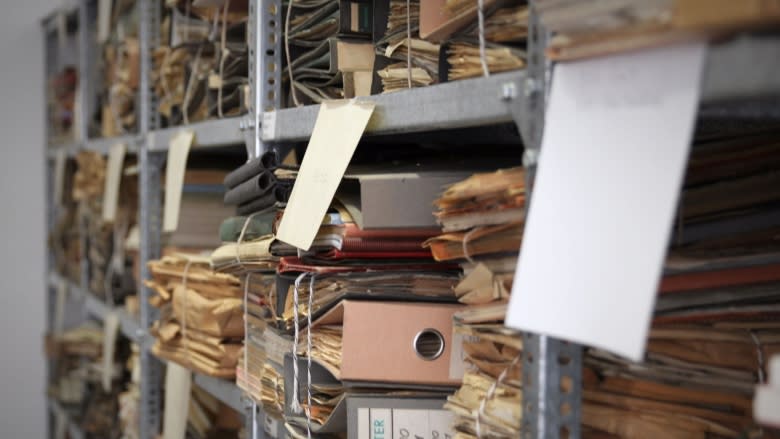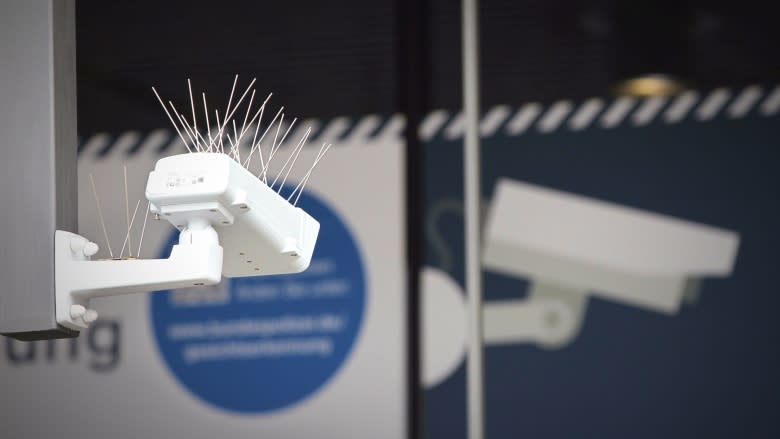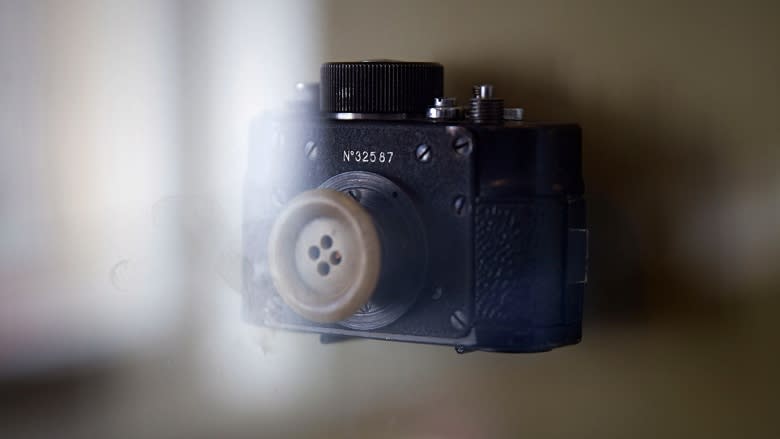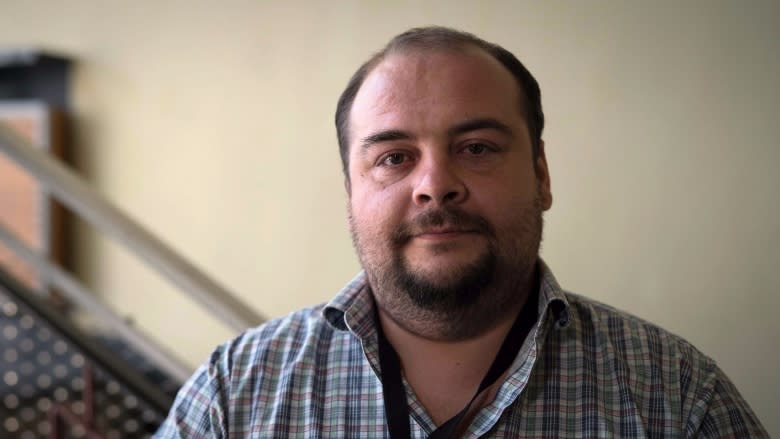Germany's new facial recognition technology reminiscent of Cold War surveillance for some
Commuters battling rush-hour crowds and a busy schedule might easily miss the notification signs as they run for their trains at Berlin's Suedkreuz station — the ones above the station entrance and on the ground warning that you are about to enter a facial-recognition zone.
In other words: Smile, you're on candid camera.
The video cameras perched high in certain parts of the station are kitted out with biometric technology. For now, they are only trying to pick out the images of about 200 volunteers who've supplied passport photos to a database.
But if the six-month trial proves successful, the government hopes to install them in train stations across Germany.
"Within seconds, images [would be] recorded and checked whether they match any images on a wanted list," German Federal Interior Minister Thomas de Maiziere told journalists at a showcase of the pilot project in August.
Surveillance state
An increase in the number of terror attacks in Germany, including the one at a Berlin Christmas market last December that left 12 people dead, has made the idea more palatable to some Germans.
But it sets off Orwellian alarm bells for many others, not least because of Germany's unique history.
Sitting in a café in the former East German city of Leipzig, Gisela Kallenbach describes herself as having led two lives.
The first, navigating the numbing webs of deceit and paranoia spun by the totalitarian regime that ran East Germany, or the former German Democratic Republic (GDR), for 40 years after the end of the Second World War.
And the second after the fall of the Berlin Wall brought the GDR crashing down along with it in 1989, paving the way for German Reunification a year later.
But the two lives are inextricably linked. And the need to keep looking back, excavating layers of the past, seems almost a compulsion.
"How can it happen that there was a state where so many people were willing to report [on] other people?" Kallenbach asks. "Friends and family!"
Stasi failed to destroy evidence
Kallenbach was one of millions of East Germans spied upon by the GDR's Ministry for State Security, the Stasi.
They kept detailed files on all their subjects. And despite efforts by Stasi agents to shred the evidence in the days just before the fall of the regime, most of the documents have been recovered.
They remain in the old Stasi headquarters — dubbed "the round-corner building" because of its shape — now a museum in Leipzig.
- CBC ARCHIVES | The Rise and Fall of the Berlin Wall
If the documents contained in the building were laid out end to end, they would stretch for 10 kilometres. And if you added in the documents from the main headquarters in Berlin and 11 other outposts, they would reach 158 kilometres.
More than seven million people have applied to read their files since the documents were made accessible in 1991. Kallenbach was one of them.
"We just wanted to know how close they were to your privacy," she says.
Now in her 70s, Kallenbach went on to become both a city councillor and a member of the European Parliament for the Green Party after the fall of the wall.
It was her environmental activism that first drew the gaze of the Stasi in the 1980s. Along with her attendance — in communist, atheist East Germany — at the St. Nicholas church, just around the corner from here, which was used as a covert meeting place.
"If you would've met me in '89, we never could have met in a coffee shop," she says. "We would've met in a secret place. Not even my apartment."
Code name 'Emerald'
Reading her file, Kallenbach discovered the Stasi had given her a code name — Emerald — and that her neigbours had been asked to inform on her.
And that a work colleague who had once delivered a veiled threat to her had, in fact, been a Stasi informer.
"There was a clear message from them, which was 'Don't do this!'" she said. "I have to admit that this communication did cause fear."
Fear was the totalitarian state's greatest tool. Along with information.
The Stasi Museum contains detailed plans of how agents would go about trying to destroy those considered enemies of the state using the information they'd gathered on their targets.
There were guidelines on how to create mistrust between friends, how to undermine someone's self-esteem and credibility and how to organize "systematic professional and personal social failure."
It has changed Kallenbach's notions of trust and how she views the modern surveillance technologies of today, especially when it comes to email.
"I avoid spreading my data as much as possible, but you can't avoid it," she says. "And I think too many people don't care about it."
The atmosphere of distrust that characterized those early years after the Stasi files were published hasn't completely evaporated — in part, because not all of the Stasi informers have been unmasked.
"After 1990, if you wanted to be in a public position or public service, you had to fill a form where you stated that you were never part of the secret service," says Kallenbach.
Many did, she says, only to be exposed later as having been a part of the Stasi machine after all.
Spy gadgetry on display
And there's more. All those bits of paper the Stasi officials tried to shred have been kept — 2,000 sacks full in Leipzig alone.
The hope is that computer software still under development will be able to help piece them back together again, but the task of laying out all the fragments for scanning can seem overwhelming.
For a look at some Cold War spy gadgetry, there's no better place than Berlin's Stasi Museum, housed in what was East Berlin's original Stasi headquarters. The offices have been kept exactly as they were in the 1980s, right down to the drab square furniture in tones of brown and more brown.
"The Stasi had 91,000 full-time employees in the end and 189,000 informants," says Felix Mueller who works at the museum as a guide. The ratio of spy to population was even greater than that of the Soviet Union.
All the tricks of the trade are on display including an array of listening devices and secret cameras designed to be hidden in belt buckles and buttonholes. There's even one fitted into the handle of a watering can.
Also on view is a machine that helped agents steam open the mail so people wouldn't know it had been tampered with. At one point, 90,000 letters a day were being intercepted.
Mueller's interest in the history of the GDR stemmed from his grandfather's role as a Stasi officer.
- PHOTOS | Pieces of the Berlin Wall around the world
"Because I belonged to a family that was basically part of the system, where a lot of people were policemen or in the [Communist] party, I only heard one side."
Mueller's father was a policeman. And although he was only 10 at the time, Mueller's memories of the fall of the Berlin Wall were vivid.
"I have a memory of confusion and fear," he said.
"[Working at the Stasi museum] was an opportunity to talk to the victims of the Stasi, to learn that the Stasi was an intelligence-gathering service like [no other.] That it was made to push through the will of the party, to control people."
The spy tools on display at the museum all seem very old-fashioned and cumbersome these days. But Mueller says the opportunities offered by surveillance of any kind — no matter how the information is gathered — don't really change.
"With intelligence gathering, there is a goal behind it. And this goal can be with, like in the Stasi, to try to take control of people, to try to take control of their thoughts. And I think this is the problem."
It's also why the old refrain "Who watches the watchers?" still has such potency in Germany today, especially for those who came from the east.

